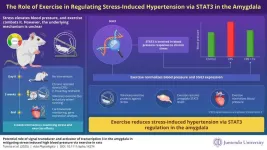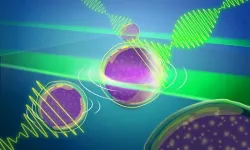(Press-News.org) An inhalable medicine with the potential to improve lung disease in people with cystic fibrosis, irrespective of their mutation type, is being tested in human trials in the UK and Europe.
Cystic fibrosis (CF) is caused by defects in the CFTR gene, which causes a buildup of thick sticky mucus in the lungs and digestive system. It causes lung infections and gradually affects the ability to breathe. The new lentiviral vector-based gene therapy works by inserting a functioning copy of the CFTR gene in the DNA of the epithelial cells in a patient’s airway.
At present, some people with CF respond well to relatively new treatments known as CFTR modulator medicines, which work by targeting the related CFTR protein. However, these are not an option for around 10-15% of patients.
The aim of the new treatment being trialled, known as BI 3720931, is to improve lung function and reduce exacerbations (flare-ups, often leading to hospitalisation), for people with CF irrespective of their mutation type – including those who genetically cannot benefit from other CF therapies.
The LENTICLAIR 1 trial, which will evaluate the safety, tolerability, and efficacy of the treatment, is being conducted by biopharmaceutical company Boehringer Ingelheim in partnership with the UK Respiratory Gene Therapy Consortium (GTC) and OXB (formerly Oxford Biomedica). Around 36 men and women with cystic fibrosis will be treated at centres in the UK, France, Italy, Netherlands and Spain.
Cystic fibrosis is an inherited lifelong disease that gets worse over time. It is estimated to affect 105,000 people worldwide. There are more than 2,000 known mutations in the CFTR gene, which lead to different levels of the severity of the disease.
Lentiviral vectors are a type of gene therapy that exploit the ability of lentiviruses to infect human cells. Lentiviruses are a family of viruses that infect by inserting their genetic material into their host cell’s genome. By modifying lentiviruses, scientists have been able to use them as a vehicle to insert beneficial genes into cells.
Professor Eric Alton, Professor of Gene Therapy and Respiratory Medicine at Imperial’s National Heart & Lung Institute, is leading the trial. He coordinates the UK CF Gene Therapy Consortium, which brings together the three centres in the UK (Edinburgh and Oxford Universities and Imperial College London) who are focused on translational respiratory gene therapy. He is also an Honorary Consultant Physician at the Royal Brompton Hospital, one of the UK trial centres.
Professor Alton said: “The UK CF Gene Therapy Consortium is very excited to have reached this milestone after 24 years of focused effort and in close collaboration with our funding partners. While the immediate target are those patients who are not eligible for CFTR modulators, this novel therapy has the potential to achieve long-lasting CFTR function improvement and disease modification for people with CF irrespective of their mutation type and importantly has the potential for re-dosing if needed.”
Professor Jane Davies of Imperial’s National Heart and Lung Institute, who is UK Lead Investigator for the trial, said: “It’s been incredible to witness the health benefits afforded by CFTR modulators, but those who cannot benefit from these drugs urgently need alternative treatments. We’re breaking new ground in this trial with a gene therapy which has the potential for long-lasting CFTR expression. I’d like to acknowledge the people living with CF who are prepared to give their time to trials of new drugs, without whom we’d be unable to make this sort of progress.”
In the first phase of the trial, different doses of the treatment will be given to evaluate safety, tolerability and select doses for Phase II. In the second phase, two selected doses or placebo will be given in a randomised, double-blind placebo-controlled dose expansion study to assess clinical efficacy and safety.
After completion of the 24-week trial period, trial participants will take part in a long-term follow-up study, LENTICLAIR-ON.
The trial is expected to be completed in early 2027. Additional information about the trial is available via ClinicalTrials.gov at NCT06515002.
ENDS
For more information please contact:
Samantha Rey
Media Officer
Imperial College London
T: +44 (0) 020 7594 1507
E: s.rey@imperial.ac.uk
This press release uses a labelling system developed by the Academy of Medical Sciences to improve the communication of evidence. For more information, please see: http://www.sciencemediacentre.org/wp-content/uploads/2018/01/AMS-press-release-labelling-system-GUIDANCE.pdf
Notes for Editors:
About Imperial College London:
We are Imperial – a world-leading university for science, technology, engineering, medicine and business (STEMB), where scientific imagination leads to world-changing impact.
As a global top ten university in London, we use science to try to understand more of the universe and improve the lives of more people in it. Across our nine campuses and throughout our Imperial Global network, our 22,000 students, 8,000 staff, and partners work together on scientific discovery, innovation and entrepreneurship. Their work navigates some of the world’s toughest challenges in global health, climate change, AI, business leadership and more.
Founded in 1907, Imperial’s future builds on a distinguished past, having pioneered penicillin, holography and fibre optics. Today, Imperial combines exceptional teaching, world-class facilities and a habit of interdisciplinary practice to unlock scientific imagination.
2. About the UK Respiratory Gene Therapy Consortium:
The UK Cystic Fibrosis Gene Therapy Consortium (GTC) comprises researchers from Imperial College London and the Universities of Oxford and Edinburgh. In 2001, the groups joined together as one organisation to share expertise and funding with a single common goal of making gene therapy for CF patients a clinical reality. The GTC has undertaken six non-viral Phase 1/2a proof-of-concept studies and the first Phase 2b gene therapy trial for CF, which met its primary endpoint. In parallel, it has developed the novel lentiviral vector which will be used in this first-in-human trial. Further details and commentary can be found at www.respiratorygenetherapy.org.uk
END
Novel inhalable gene therapy trialled for people with cystic fibrosis
Researchers at Imperial College London are leading human trials for the innovative treatment
2025-02-20
ELSE PRESS RELEASES FROM THIS DATE:
Plasma arc cutting: PNU and KIMM scientists together decode gas flow dynamics
2025-02-20
Plasma arc cutting (PAC) is a thermal cutting technique widely used in manufacturing applications such as shipbuilding, aerospace, fabrication, nuclear plants decommissioning, construction industry, and the automotive industry. In this process, a jet of plasma or ionized gas is ejected at high speeds, which melts and subsequently removes unwanted parts of materials from electrically conductive workpieces such as metals. The plasma jet is typically produced in two steps: pressuring a gas through a small nozzle hole and generating an electric arc via power supply. Remarkably, the introduced arc ionizes ...
Exercise your way to lower blood pressure: Brain pathway to fight high blood pressure
2025-02-20
Hypertension (high blood pressure) is a debilitating condition and a major cause of premature death worldwide. Chronic stress plays a significant role, but the underlying mechanism involving biochemical pathways by which stress leads to hypertension has not been well understood. Understanding these pathways could lead to the development of therapeutic agents to combat hypertension. Now, a new study from Juntendo University, Japan, led by Professor Hidefumi Waki, Dr. Keisuke Tomita, and Dr. Ko Yamanaka, published online in the journal Acta Physiologica on January 13, 2025, has shown that voluntary ...
Scientists call for efforts to protect habitats of critically endangered shark species
2025-02-20
A critically endangered species of shark could be forced to adapt to new habitats – or face extinction – as a result of changes in the ocean predicted to occur as a result of climate change, a new study has suggested.
The whitefin swellshark (Cephaloscyllium albipinnum) is a species of catshark found in deeper waters just off Australia’s south and east coasts. Its precise population numbers are uncertain, but the species has been assessed by the International Union for Conservation of Nature (IUCN) as Critically ...
New ACS study shows cancer mortality rates among Black people declining, but remain higher than other racial and ethnic groups
2025-02-20
The American Cancer Society (ACS) today released Cancer Statistics for African American and Black People, 2025. According to the report, the cancer mortality rate declined from 1991 to 2022 by 49% and 33% in Black men and women, respectively, in the United States. However, African American and Black people continue to have a disproportionately elevated cancer burden compared to other population groups. According to the study, the risk of cancer death for Black individuals is two-fold that of White individuals for myeloma, prostate, uterine corpus (endometrial), and stomach cancers, and 40%-50% higher for colorectal, ...
Latest research finds people with certain heart conditions may play competitive sports
2025-02-20
Statement Highlights:
Although people with cardiovascular abnormalities have previously been considered ineligible for competitive sports participation, new evidence indicates that athletes of all ages who have certain heart abnormalities or diseases may often safely participate in competitive sports.
A new joint scientific statement from the American Heart Association and the American College of Cardiology emphasizes the need for shared decision-making between athletes and their clinicians, and provides guidance for health care professionals about how to assess risk when considering competitive sports participation for people with various cardiovascular conditions.
More ...
Biologists discover a new type of control over RNA splicing
2025-02-20
CAMBRIDGE, MA -- RNA splicing is a cellular process that is critical for gene expression. After genes are copied from DNA into messenger RNA, portions of the RNA that don’t code for proteins, called introns, are cut out and the coding portions are spliced back together.
This process is controlled by a large protein-RNA complex called the spliceosome. MIT biologists have now discovered a new layer of regulation that helps to determine which sites on the messenger RNA molecule the spliceosome will target.
The research team discovered ...
Surprising finding for acid reducing drugs
2025-02-20
Acid reducing medicines from the group of proton pump inhibitors (PPIs) are best-selling drugs that prevent and alleviate stomach problems. PPIs are activated in the acid-producing cells of the stomach, where they block acid production. Researchers at the German Cancer Research Center (DKFZ) made the surprising discovery that zinc-carrying proteins, which are found in all cells, can also activate PPIs – without the presence of gastric acid. The result could be a key to understanding the side effects of PPIs.
Excessive gastric acid can cause not only heartburn, but also chronic complaints such as gastritis or even a stomach ...
Pushing the limits of ‘custom-made’ microscopy
2025-02-20
A new paper updates an EMBL technology advance even further. More details about the original technology can be found in our initial reporting here.
EMBL tech developers have made an important leap forward with a novel methodology that adds an important microscopy capability to life scientists’ toolbox. The advance represents a 1,000-fold improvement in speed and throughput in Brillouin microscopy and provides a way to view light-sensitive organisms more efficiently.
“We were on a quest to speed up image acquisition,” said Carlo Bevilacqua, lead author on ...
Deep Nanometry reveals hidden nanoparticles
2025-02-20
Researchers including those from the University of Tokyo developed Deep Nanometry, an analytical technique combining advanced optical equipment with a noise removal algorithm based on unsupervised deep learning. Deep Nanometry can analyze nanoparticles in medical samples at high speed, making it possible to accurately detect even trace amounts of rare particles. This has proven its potential for detecting extracellular vesicles indicating early signs of colon cancer, and it is hoped that it can be applied to other medical and industrial fields.
Did you know your ...
Screen time linked to bipolar and manic symptoms in U.S. preteens
2025-02-20
Toronto, ON - Preteens who spend more time on screens are more likely to develop manic symptoms years two-years later, according to a new study published in Social Psychiatry and Psychiatric Epidemiology.
The findings reveal that 10- to 11-year-olds who engage heavily with social media, video games, texting, and videos show a greater risk of symptoms such as inflated self-esteem, decreased need for sleep, distractibility, rapid speech, racing thoughts, and impulsivity — behaviors characteristic of manic episodes, a key feature of bipolar-spectrum disorders.
“Adolescence is a particularly ...
LAST 30 PRESS RELEASES:
New research by ASU paleoanthropologists gives valuable insight into how two ancient human ancestors coexisted in the same area
Therapeutic use of cannabis and cannabinoids
‘Cognitive Legos’ help the brain build complex behaviors
From inhibition to destruction – kinase drugs found to trigger protein degradation
Diamond defects, now in pairs, reveal hidden fluctuations in the quantum world
Metastatic recurrence among adolescents and young adults with cancer
Disrupted federal funding for extramural cancer research
Glucagon-like peptide-1 receptor agonists and chronic cough
The 2025 Los Angeles wildfires and outpatient acute health care utilization
Why watching someone get hurt on screen makes you wince
Data-driven surgical supply lists can reduce hospital cost and waste
Plants use engineering principles to push through hard soil
Global burden and mortality of amyotrophic lateral sclerosis and other motor neuron diseases in 204 countries and territories, 1990–2021
Research into zoonotic disease risks requires a One Health approach
The seamounts of Cape Verde: a biodiversity hotspot and a priority for marine conservation in the central-eastern Atlantic
Scientists uncover how a mitochondrial mutation rewires immune function
Do children imitate communication manners of machines? Experiment on children's response to polite vs. commanding robot
Tiny traps, big trouble: Small regions within cells aggregate proteins linked to ALS, dementia
The future of type 1 diabetes: Can stem cells provide a cure?
UBC researchers uncover how statins harm muscles—and how to stop it
SwRI tackles pre-ignition challenges in hydrogen-fueled engines
Making LAZY plants stand up: Research reveals new pathway plants use to detect gravity
HBNU researchers propose novel sensor-integrated wrapper for food quality monitoring and preservation
Role of ubiquilin-2 liquid droplets in α-synuclein aggregation
Hanyang University researchers proposed novel technology for environmental infringement and sag estimation for transmission lines
Pro fighters risk damage to the brain’s ‘garbage disposal’
AI tops density in predicting breast cancer risk
Pesticides and other common chemical pollutants are toxic to our ‘good’ gut bacteria
Chemists design OLEDs that electrically flip the handedness of light
Experimental mRNA therapy shows potential to combat antibiotic-resistant infections
[Press-News.org] Novel inhalable gene therapy trialled for people with cystic fibrosisResearchers at Imperial College London are leading human trials for the innovative treatment



